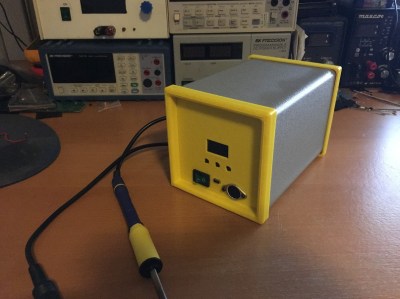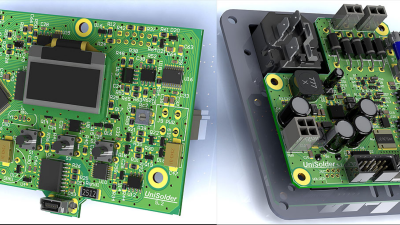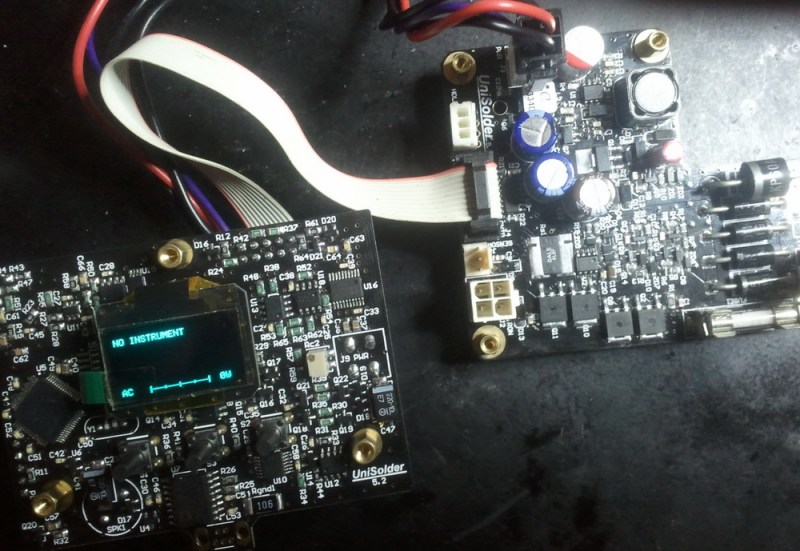If your favourite programming language is solder, they you’ve surely worked your way through a bunch of irons and controllers over your hacker existence. It’s also likely you couldn’t pick one single favourite and ended up with a bunch of them crowding your desk. It would be handy to have one controller to rule them all. That’s just what [sparkybg] set out to do by building his Really Universal Soldering Controller. His intent was to design a controller capable of driving any kind of low voltage soldering iron which used either an in-line or separate temperature sensor (either thermocouple or resistive PTC).
 This project has really caught on. [sparkybg] announced his build about two years back and since then many others have started posting details of their own Unisolder 5.2 builds. [zed65] built the version seen to the right and [SZ64] assembled the boards shown at the top of this article.
This project has really caught on. [sparkybg] announced his build about two years back and since then many others have started posting details of their own Unisolder 5.2 builds. [zed65] built the version seen to the right and [SZ64] assembled the boards shown at the top of this article.
The controller has been proven to work successfully with Iron handles from Hakko, Pace, JBC, Weller, Ersa, as well as several Chinese makes. Getting the controller to identify one of the supported 625 types of iron profiles consists of connecting two close tolerance resistors across the relevant pins on the 9-pin shell connector. This is a brilliant solution to help identify a large variety of different types of irons with simple hardware. In the unlikely situation where you have a really vague, unsupported model, then creating your own custom profile is quite straightforward. The design is highly discrete with an all analog front end and a PIC32 doing all the digital heavy lifting.
To get an idea of the complexity of his task, here is what [sparkybg] needs to do:
“I have around 200 microseconds to stop the power, wait for the TC voltage to come to its real value, connect the amplifier to this voltage, wait for the amplifier to set its output to what I want to read, take the measurement from the ADC, disconnect the amplifier from the TC, run the PID, and eventually turn the power back on. The millivolts to temperature calculation is done using polynomial with 10 members. It does this calculation using 32bit mantissa floating point numbers and completes it in around 20 microseconds. The whole wave shaping, temperature calculation, PID and so on is completed in around 50-60 microseconds. RMS current, voltage and power calculations are done in around 100 microseconds. All this is done between the half periods of the mains voltage, where the voltage is less than around 3 volts.”

The forum is already over 800 posts deep, but you can start by grabbing the all important schematic PDF’s, Gerbers, BoM and firmware files conveniently linked in the first post to build your own Unisolder5.2 controller. This Universal Controller is a follow up to his earlier project for a Hakko T12/T15 specific controller which gave him a lot of insight in to designing the universal version.
[sparkybg] has posted several videos showing the UniSolder5.2 controlling several types of Irons. In the video after the break, he demonstrates it controlling a Weller WSP80.
















Excellent build. Now let’s wait for cheap Chinese clones.
you will wait till the cows come home
chinese like to clone brand stuff badly, not good obscure stuff well
I would buy this
I would buy this as well!
Does anyone sell kits?
id buy one.
I only use Metcal.
Maybe we should build an open source 13MHz power supply ;)
Scuse me sir,but do you mean something like this one ?
http://www.eevblog.com/forum/projects/diy-metcal-13-56-mhz-rf-supply/msg169781/#msg169781
OMG Forums are really the worst. I there really no source code repo?
The BOM of that project is just insanity. But I think I managed to add half of it to my Digikey cart. Perhaps that is just the way I have to go…
A bit over engineered to my taste but nice and complete ;)
+1
old news, no one makes them anymore, too complex compared to the chinese OLED controllers.
Seems like a nice project…
but why build this when you can buy cheap product like:
http://www.kurtzersa.com/electronics-production-equipment/soldering-tools-accessories/soldering-desoldering-stations/produkt-details/i-con-pico-1.html
That are just perfect… I use that one, heat up in a few seconds, high power, the handle is really light and fits nice in hand…
I doubt you can build the proposed controller for less than what you pay for such product, it seems quite overengineered
+1
ERSA make some beautiful irons. The iCON is also really well priced for what you get. Not as punchy as the high end ERSA kit, but really good value for money!
Looks nice and small, do you know what the grip-to-tip distance is? (I’m on the hunt for something nice and short for precision work)
when you said cheap, I was hoping for less than $60 … temperature control is not that hard…
because despite looking modern it is:
-using ancient separate tip/heater design, almost whole 1cm between end of heater and the tip…
-pico heater cap holder is plastic and will break if you change tips often
-there is potted electronics in the handle
-they die a lot resulting in ERROR 5/8 on the display, usually handle/heater goes bad
-tips cost same as whole T12 cartridges
costs the same as hakko 951
I find this as a nicely designed hobby project. But at the same time, over engineered.
I prefer however where things are heading: control + small display in the handle of the iron.
Such complexity and then the iron profiles needs two close tolerance resistors, in 2017? :/
I hope that is just one of the options not the only one.
Using a $0.04 e2prom or even a $0.50 mcu for each handle makes the irons independent of the controllers and would’ve been more convenient and cheaper than to source a range of close tolerance resistors for programming, and virtually for free.
As is done with SPD SDRAM, EDID HDMI and used even in VGA displays since forever, well, 30 years ago.
But its easier to integrate two resistors into the plug of the soldering iron cable. You would need to add the eeprom into the plug which would be a bit tight. And then you need a plug with 4 additional wires(VCC, GND, SCL SDA) which would possible increase the cost of the connector. Of course i would be nice if every iron manufacturer would build a eeprom into the handle but why would they. They dont even have a universal station for each manufacturer instead you have to buy a different station for every iron.